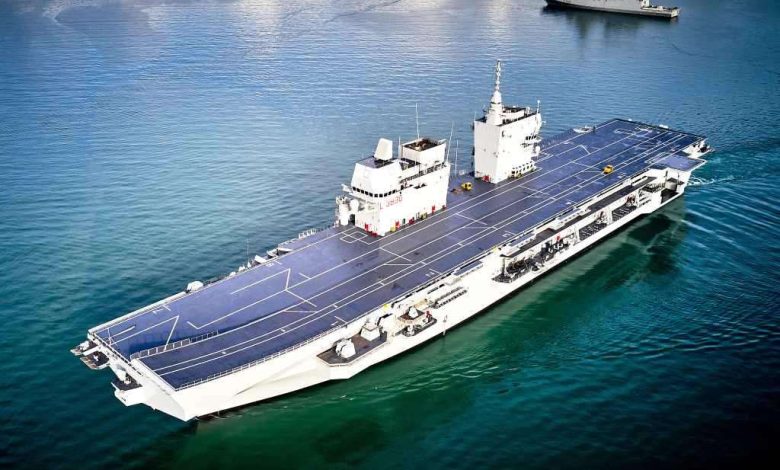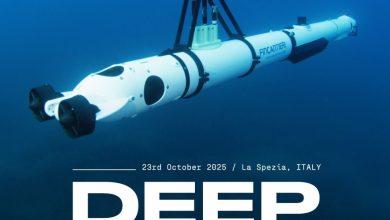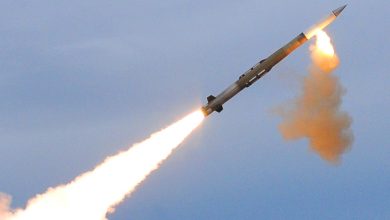
Fincantieri Unveils the ITS Trieste: A Cutting-Edge Landing Helicopter Dock for the Italian Navy
During a ceremony held at Leghorn port on 7 December, Fincantieri transferred the Landing Helicopter Dock (LHD) Trieste to the Italian Navy. The occasion was graced by Italy’s President Sergio Mattarella, Defence Minister Guido Crosetto, Chief of Defence General Luciano Portolano, and Navy Chief Vice-Admiral Enrico Credendino. Simultaneously, officer cadets from the Naval Academy pledged their solemn oath aboard the vessel.
The transfer of the Trieste, a ‘multirole’ LHD to the Marina Militare, signifies the completion of a journey that commenced approximately 14 years prior with the signing of a €1.1 billion agreement between the Italian MoD’s Naval Armaments Directorate (NAVARM) and a consortium led by Fincantieri as the main contractor, with Leonardo acting as the combat system integrator, alongside MBDA Italia and ELT Group as primary subcontractors. This contract also encompassed a logistics and training package.
“This is the outcome of the efforts of countless individuals: engineers, technicians, and laborers. Only a handful of nations possess the capability to create an ingenious and technologically advanced project like this, a blend of history, expertise, and cutting-edge technology,” stated Minister Crosetto, emphasizing that the vessel’s core lies in the crew, embodying their values, ideals, and spirit of collaboration, referring to the 150 officer cadets of the Naval Academy who took their solemn oath for the first time aboard a ship.
Engineered and conceptualized under the ‘dual-use’ and ‘one fits all’ principles to undertake various missions—from supporting amphibious operations and power projection from the sea in national, joint, and multinational contexts, along with command and control capabilities—to assisting Civil Protection and international agencies in disaster response, humanitarian, medical, and evacuation operations, the newly commissioned ship will also function as an ‘alternate aircraft carrier,’ facilitating operations of the national 5th generation aerial component based on the F-35B STOVL model when the Cavour STOVL carrier is unavailable for maintenance or operational needs.
“With the delivery of the Trieste, the Navy is furnished with a representation of modernity and national technological prowess, a significant asset that will enhance our national power projection and deterrent capacity, particularly in the present historical context marked by emerging threats to security, especially in light of recent occurrences in the Middle East,” remarked General Portolano.
In line with the modernization of Italy’s military capabilities, the Trieste LHD stands out as a groundbreaking development, the inaugural unit of its type constructed by the Italian shipbuilding sector. This multipurpose amphibious assault vessel demonstrates technical excellence with enhanced projection capacities, enabling amphibious assault missions and ensuring prolonged operational presence, supported by its high logistical autonomy,” expressed the Italian Navy Chief during the ceremony, adding that the new vessel is equipped with provisions and growth potential for operating aerial, surface, and underwater unmanned systems.
“With its advanced technological and operational attributes, this unit not only bolsters Italy’s international presence but also showcases Fincantieri’s excellence as a dependable and innovative defense partner,” stated Pierroberto Folgiero, CEO and General Manager of Fincantieri.
Designated for the 3rd Naval Division, the Trieste LHD will be stationed in Taranto following the completion of initial training in La Spezia. It serves as the flagship of the Amphibious Task Group (ATG), which, along with the Carrier Strike Group (CSG, led by the Cavour carrier), constitutes the Expeditionary Task Force (ETF), the operational segment of the Italian Navy fleet. The operational capability of the F-35B is anticipated to be achieved after the completion of platform warranty work, with specific system installations by Fincantieri scheduled for Q3 2025, followed by certification processes conducted by the F-35 Joint Program Office in the United States.
Engineered as an LHD, the platform features an overall length of 245 meters, a width varying from 36 meters at the flight deck to a maximum of 55 meters including operational elevators, a construction height of 27.7 meters, and a full load displacement of 36,770 tonnes. The Trieste boasts a full-length deck with a starboard-positioned island comprising two distinct blocks, two lateral elevators linking the flight deck to the hangar located in the central-rear area, a NATO Role 2E hospital, accommodations, and C4ISR facilities situated in the bow-central sections on the lower decks, along with a stern well deck.
Certified by RINA Services in accordance with the latest international anti-pollution and green regulations, the new platform offers extensive accommodations and living quarters for a total of 1,064 personnel, comprising a 360-crew contingent, while the remaining beds are allocated among aviation, support, command and control, and amphibious functions. Thanks to its transport and aviation capabilities, the Trieste LHD is set to ensure the operational capabilities of the embarked 600-strong amphibious battalion. Extensive provisions are also dedicated to NATO’s ‘Role 2E’ hospital and interoperable C4ISR within NATO.
European and global competitions. It will also be equipped to supply drinkable water and electrical energy ashore during disaster relief and humanitarian missions.
The aft 50 x 15 meters well deck can hold up to four new type LC-23 LCM (Landing Craft Medium) or one LCAC (Landing Craft Air Cushion) in addition to an organic element consisting of two 15 meters combat boats and two each of 7.1 and 9.3 meters RHIBs.
The Trieste LHD features an 18×50 meters garage deck that can accommodate military and civilian vehicles including main battle tanks weighing over 60 tonnes and is capable of hosting up to 1,200 linear meters of vehicles, also utilizing the hangar and flight deck areas. Vehicles can board the vessel through the rear ramp as well as the starboard ramp.
The 230 x 36 meters flight deck, incorporating a 12° ski-jump, provides nine helicopter landing spots; it can support both rotary- and fixed-wing aircraft including EH-101, NH-90, CH-53, CH-47, AV-8B, and F-35B air assets on the flight deck and the 107.8 x 25 meters hangar. In aircraft carrier setup, the Trieste LHD is capable of accommodating up to 20 F-35Bs and two NH-90 helicopters.
With a propulsion system configured in a CODOGOL (Combined Diesel Or Gas Or eLectric) layout centered on dual shafts with controllable pitch propellers and rudders supplied by Fincantieri and relying on two Rolls-Royce MT30 gas turbines rated at 38 MW each, two MAN 20V32/44CR diesel engines rated at 12 MW each, and two 2.25 MW each General Electric Power Conversion electric motors, this new vessel can achieve a top speed of 25 knots on gas turbines, 18 knots on main diesels, and 10 knots on electric motors. Power generation for both ship systems and propulsion is ensured by four 5.4 MW each MAN 9L32/44CR generators.
Designed under the Legge Navale or Naval Law initiative, the Trieste LHD harnesses the latest advancements in electronics and system technologies. The Integrated Platform Management System is built upon the Fincantieri Nextech SEASNavy next-generation system, while the SADOC Mk4 represents the latest version of the Command Management System developed by Leonardo for the new breed of Italian Navy’s frontline vessels. Leonardo also supplies the foundation of the comprehensive communication suite with software-defined radios, multiple data links processors, and SATCOM, while the navigation radars are sourced from GEM Elettronica.
The integrated sensors package includes the Leonardo next-generation four fixed-faces X-band StarFire AESA radar (with provisions for the C-band radar of the Dual Band Radar suite) and the next-generation L-band Kronos Power Shield early warning radar notable for its AESA rotating antenna and full digital structure featuring ‘digital beamforming’ for extensive-range surveillance, detection, and tracking of both aerial and ballistic missile targets. These radars are paired with the new Leonardo SIR-M-PA IFF system outfitted with conformal antennas alongside the next-generation EW suite created and provided by the ELT Group, based on an EW manager managing Radar Electronic Support Measures, Communication ESM, and Radar Electronic Counter-Measures systems. The EW suite is connected to Leonardo’s two ODLS-20 (Oto Melara Decoy Launching System) decoy launchers for comprehensive air, surface, and underwater defense.
The LHD will also utilize the same Distributed Static Staring IRST EO/IR package from Leonardo, which is also installed on the PPA Full, in addition to the Sitep Italia Multirole Acoustic Stabilized Systems equipped with surveillance and non-lethal weaponry, including the acoustic cannon and laser dazzler.
The air traffic and approach systems encompass the Leonardo SPN-720 solid-state, low probability of Intercept (LPI) naval precision approach radar, the Thales Italia TACAN, and Calzoni visual landing aids. Additional apparatus will be incorporated into the suite designed for F-35B operations.
The vessel’s defense against aerial, missile, and surface threats is guaranteed through three Leonardo 76/62 mm Super Rapido Multi-feeding gun mounts in the Davide (Strales for international sales) layout featuring DART guided munitions, managed by a dual radar/EO NA-30S Mk2 fire control system and three remote-controlled KBA 25/80 mm artillery with EO/IR FCS. The ship is also fitted-for but not equipped with (Level 1) the MBDA Italia SAAM Extended Self-Defence air-defense system based on two vertical launching systems (2×8 cells each) for the Aster 15/30 positioned on the starboard side. Underwater defense is assured by the Obstacle Avoidance System sonar from Leonardo in conjunction with the Black Snake towed-array torpedo detection system integrated with a Reaction Management System and the two OLDS-20 decoy launchers.






